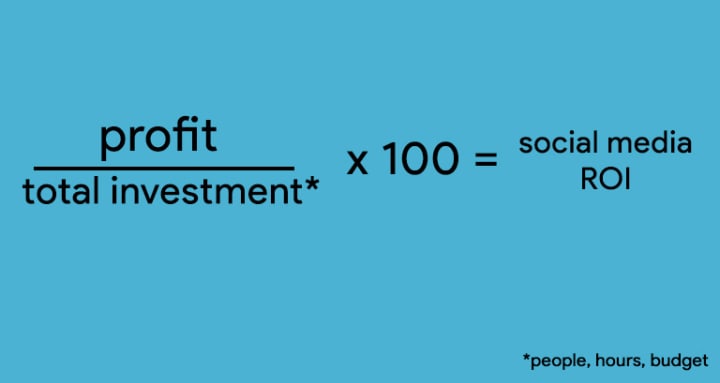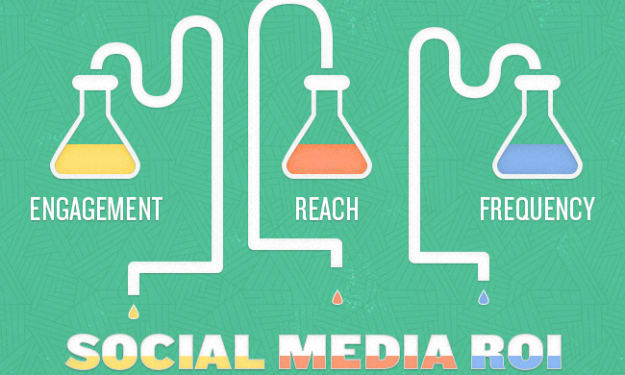Understand, Measure, and Report Social Media ROI
Let's prove that social media can help the overall business goals.

So if you read my last post then you’ll know that 40 percent of businesses cannot accurately measure the ROI of their social media. The following post is for the 40 percent. Let’s ensure that everyone can measure the ROI of social media.
Social media creates mass amounts (for certain companies) of inbound revenue, however, you have to demonstrate this before budgets are loosened for you to spend with. Your aim isn’t just to prove to your superior that yes, social media has generated revenue, but it allows you as a marketer to measure and track the revenue and then dedicate more time to the streams that are working for you and to improve on the streams that aren’t.
Social Media ROI—What Is it?
Every organisation will be different when determining what the purpose of their social media channels are, from brand awareness, customer service, revenue, etc. however, for the most part, social media ROI the sum of response on any given platform that results in value creation. Looking past the time spent working on campaigns or manning the social streams, and the resources being used to deplete this time whats the return?
If you’re here to learn how to measure the revenue then here’s a simple formula:

So, if you made £1000 from social media, but your staff and/or budget spend for promotion was £500 then your profit would also be £500. Using our little formula above, £500 profit / £500 investment x 100 = 100% return on your investment.
However, that’s not the be all and end all of proving your social media is giving you ROI.
Not all businesses will have the ability to directly link their revenue to their social media campaigns/output. Business value isn’t always measured by a monetary value. Linking the ROI of your social media to such a narrowly defined objective counteracts you from defining the vast amount of other ways your social media is a working part of your marketing approach.
If your sole aim is to increase brand awareness then inbound revenue wouldn’t be at the forefront of your measure, metrics relating to reach, engagement, and click-through rates; all of which are non-profit metrics.
Author Oliver Blanchard states that non-profit metrics offer the ability to “tell the story by capturing changes in human behaviour”. Knowing your audience and their changes/behavioural aspects you can then ask the following questions once you complete a campaign.
What did your target audience then do once they had been exposed to your campaign? Did their actions help you reach your pre-determined campaign objectives? If they did, where didn’t you hit your goals? Now, knowing this information, what can you do next time you run a campaign?
If you would like another way to look at your social media ROI, try creating a ratio that defines the difference between the gain and the cost, this takes into account all aspects of your business; training, the technology used, outside hired help (consultants or agencies), overheads, etc.
When gauging the gain from specific consumer conversions (buying, viewing, subscriptions etc.) your analytical data will be crucial for understanding which conversions can be directly linked to your social media output. This, of course, please a large part in knowing your social media ROI and showing the effectiveness of social media for your business.
Why Measuring ROI Is Important?
Taking a look at my previous post you’ll see that 40 percent of businesses do not measure their social media impact properly. Certain businesses have multiple stakeholders or clients who need convinced that a wider marketing budget is required and who don’t really care about how much you harp on about social media, hard facts/stats is what will help you fight your corner.
Having a tangible aspect to put on screen or handouts at your next meeting that shows measurable outcomes that are relative to the overall business goals will let you be taken much more seriously.
Measuring the ROI of social media is important for several reasons, from knowing the perception of social media internally and externally to knowing the downfalls in your marketing plan that needs to be rectified. Measuring your social media appropriately will allow for better content creation (have a read at this article here that tells you how) and will help you gain a stronger understanding, and bond, between the business persona and the consumer.
Measuring Your Social Media ROI: Objectives, Goals, and Metrics
While it is important to set campaign goals, and goals for your social media, and execute them, the work isn’t complete until the evaluation of your execution has been completed.
With that in mind, let’s look at setting some social media goals/objectives for your campaign.
Social media plays a vital part in creating brand awareness and brand notability; something that is very easy to measure with the use of likes, shares, or comments. However, as much as it is valuable to your business, it is not enough to show strong ROI. To show the full value of your social media output, similar to your overall campaign, you need to set some objectives, objectives that complement existing goals of your business… and that are SMART.
Smart objectives ensure that you have a specific purpose, that can be measured, it’s purpose is achievable… and realistic, and has a time frame, a date in the future in which you hope to meet this goal.
Your social media objectives can be built around several things; conversion, brand image, and customer engagement/experience. Conversions are where you can show tangible value and measure the ROI of your social media, your conversion goals can be anything from revenue to a client sign up (mailing list, subscription, etc.).
Setting Social Media Objectives That Show ROI
Your objectives should be a representative of what your social media can do for your business. When you the objectives outlined you then might wish to create some ‘mini-goals’ so to speak, tasks in which you know can help you smash your objectives. Sticking to the SMART objectives means you have something really specific (e.g. have x amount of sign-ups by end of December 2018) but you also have a time in which you need to complete it by, rule of thumb, try hit before the date so you can avoid the disappointment of a failed objective, mini goals can help with this and may even encourage you to push harder before you fall short.
Regardless of your objectives, a smart step would be to audit your social media before and after you create and then complete goals. Looking at your current standing to create SMART objectives, remember, making them achievable and realistic is key so you need somewhere to start.
Which metrics help you measure?
Social media metrics, built-in tracking on the specific platform (followers, likes, comments, and shares) are typically referred to as ‘vanity points’ but it’s important that you don’t completely disregard these as they are still quantifiable data.
This data is crucial for understanding the worth of your social media, how you compare to the competition and help you decide on future content. (Learn more about future content with data understand). These metrics are only ‘vanity points’ when they are playing no part in aiding your overall business goals. Social media data should be relevant to all stakeholders at your business, not just the marketing/social media team, if your marketing team set different goals from the rest of the business, creating campaigns can be very difficult.
The recommendation amongst marketers is that you use data that has a tangible response to the overall business objectives; reach, audience engagement, site visits, generated leads, conversions, inbound revenue etc.
Social Media ROI Tool Bag
Ok, so I’ll stop the theory behind social media ROI measurement and tell you the tools that can set up those conversion funnels, mark customer action points, analyse data, and create a report of the results.
If you need to know the data on your website, the proof you’ve sent all those likes and shares to buy the product, then Google Analytics will be your best friend. From tracking traffic, on-site conversions, time spent on site, revenue made and so much more, Google Analytics will track every piece of movement a customer makes on your site… which you can then segment to see just social acquisition. If you’re based in the UK there may also be some free training from Google near you that can help you understand Google Analytics a little bit better. Find out more info here.
Every social media managers favourite little owl, Hootsuite, has a great tool for showing you the return on investment of your social media efforts. Give it some basic information about the campaign and it’ll calculate the ROI. Find it here. So you know the proposed ROI from their calculator, but what about the actual ROI of your social media (paid, owned, and earned channels)? Well, Hootsuite has the answer to that too, check out Hootsuite Impact.
The Facebook Pixel, a piece of code that you place on to your website and then track conversion from your Facebook Ads; leads, sales, sign-ups, online form etc. The pixel can be used on Facebook’s own advertising manager platform or some third party ad optimisation and targeting tools like AdEspresso.
The Big Reveal
It’s now time to present the findings—What was the ROI and how do you tell everyone? The ability to track should be built into all platforms you use on social media, and very easily found, so measuring (or proving for some) the success of the campaign is readily available.
When reporting your findings it’s best to skip the jargon, when it comes to the time to report you’ll almost be speaking a new language, Social Data… however, the rest of the company probably won’t be as fluent in this new language as you. Using plain text and relatable comparisons will ensure you keep everyone's attention.
Don’t be afraid to use templates when trying to piece the report together, loads are available online, just make it your own! Use your template to show what you have done has added value to the overall company objectives, align your results with the companies larger growth ideas. If you had trouble hitting some goals or numbers, make sure you articulate any limitations, your superiors need to know what you need from them to keep hitting targets.
Measuring your SM ROI will give your company an understanding of the work you are doing and why it is valuable for the success of the company. There’s always more to learn, develop, test, practice etc. which means there is always more to gain from social media.
About the Creator
Francis Milligan
28. Glasgow, UK.
Social Media Lead. Agency Owner. Marketing Lecturer.






Comments
There are no comments for this story
Be the first to respond and start the conversation.